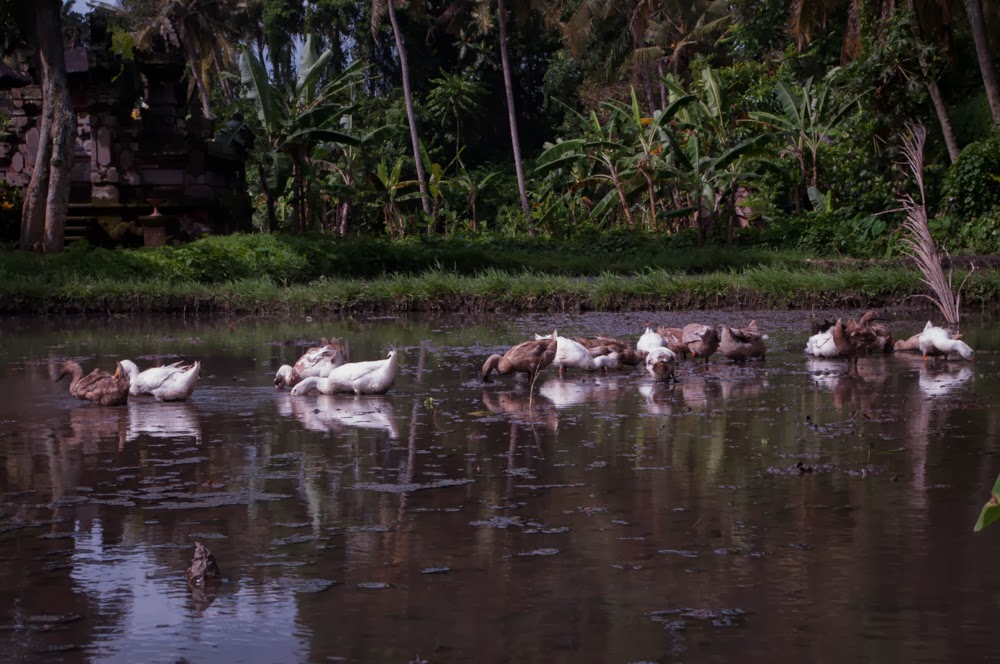1-8 Museums and Rice Paddies
 |
| The gates to the museum. Impressive, no? |
Our second day in Ubud, we decided to go look for culture and rice paddies. The Agung Rai Museum of Art (ARMA) was supposed to be one of the best art museums in Bali, and it was in the same direction as some rice paddies I wanted to take pictures of. So, we went exploring.
The ARMA was pretty neat. As usual, I don’t have the artistic background to appreciate modern art. There were 2 pieces that stood out to me. One was a painting covered in religious symbols. Each symbol was in a little box and the boxes made rows. I think if I knew more about the symbols in question, it would have been a fascinating piece. As it was, I could recognize the Hindu and Buddhist origins but that was about all. The second artist had squeezed the paint out of the tube in long lines. She layered them on top of each other with spaces in between to make an amazing 3D effect in the rice fields, on the hat of the workers and the thatch of the houses. I thought that was pretty cool.
 |
| Me, trying to carve. |
More interesting was the “traditional” section. There were traditional style paintings from a huge range of time periods. The older ones were batik images showing scenes from Hindu epics while the newest one depicted the Tiger plane crash in April, 2013. It was interesting to see the different influences throughout history and how they chose to display them in the museum. The paintings from around WWII had a distinctly Japanese cast, everything from flowers and mountains to the way the human form was depicted. The more modern ones had more colors per image while the older ones had one main color and then one or two highlight colors. (I wonder if this comes from the history of batik, in which colors are layered over one another with the negative spaces created by wax.)
 |
| The path to the paddies |
After we wandered around the galleries, we went out to the wood carving demonstration. The carver allowed us to try, but we were both being timid. I was afraid I would ruin it, which made him laugh. He didn’t seem to think I could, which looking at his other stuff, I’m not sure I could have. I think he would have just incorporated it back into the work and no one would ever know the difference.
We wandered out the back of the museum into a rice paddy. At first, the path was nice and neatly kept with stepping stones to walk on. Then, it turned into plain concrete, and finally into raised mud. I think we were further than most tourists go, but it was interesting. The first ones we were walking through were all plain mud. There were little nurseries in the corner with bright green rice seedlings while ducks roamed the mud. We met a nice old farmer working on blocking his seedlings from the ducks, but we couldn’t communicate much with him.
 |
| Duck, duck, grey duck (or brown duck) |
After awhile, we wandered out the back of the rice paddies and into a little neighborhood. On a whim, we followed a sign that said “Kris display” (‘Kris’ are the Hindu swords.) The sign pointed into someone’s household complex. We walked in and stood there in confusion for awhile. An old lady found us and brought us to the kris display. There were a bunch of beautiful kris with stunningly rippled blades. She had a wide variety of ages of the blades. They were her husband’s but he died and She was trying to sell some to us, but we turned her down and left. I think she needs to sell them to a museum.
 |
| Down the alley |
The contrast between the curated art museum and the back room of an old woman’s house didn’t even strike me until the evening. Somehow, it seemed to fit that both of those things would exist basically side-by-side in Ubud. There were a lot of contrasts like that in Ubud.
 |
| Rice paddies tucked in behind the main road |
